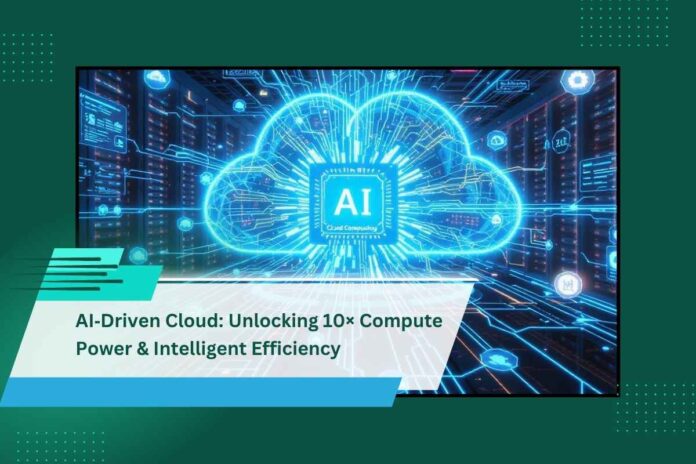Cloud computing has already reshaped business and technology landscapes by offering scalable, on-demand compute and storage. But as artificial intelligence (AI) evolves, it’s unlocking a new era making the cloud ten times more powerful than before. This transformation unfolds across multiple dimensions: performance, efficiency, intelligence, resilience, and the ability to create game-changing applications. Let’s explore why AI-powered cloud infrastructure marks a transformational inflection point.
1. Smarter Resource Management: Efficiency at Scale
Cloud providers juggle countless virtual machines, servers, and containers daily. AI-driven resource orchestration automates this complex balancing act by:
- Analyzing workload patterns to optimize allocations
- Dynamically scaling resources to meet demand
- Reducing idle resource wastage
We notes that AI’s intelligent automation of elasticity, load-balancing, and prioritization significantly boosts cloud performance and cost control. Reinforcement learning researchers also report 20–30% higher resource use efficiency and up to 40% cost savings over legacy methods. The outcome? Clouds that think ahead, scale on demand, and operate leaner.
2. Turbocharged Compute: Specialized Hardware & AI Hypercomputers
Cloud providers are deploying cutting-edge AI-focused hardware, radically increasing compute density:
- Google’s next-gen TPU-powered AI Hypercomputer enables 10× performance gains over prior architectures.
- Edge compute devices and DPUs offload mundane network tasks, freeing GPUs and CPUs for AI workloads.
- Amazon’s Trainium chips and AWS’s Project Rainier initiative reflects a similar bet designing AI-first data centers supported by bespoke silicon.
- Startups such as Cerebras and CoreWeave are building wafer-scale engines and GPU-rich clusters, specifically tuned for AI inference.
These advances yield up to tenfold speed-ups driving AI applications from real-time analytics to large-language model inference. Factor in emerging optical-cloud and chip-memory co-design trends, and we’re entering a new compute paradigm.
3. Autonomous Operations and Predictive Maintenance
AI is transforming cloud infrastructure from reactive to proactive. Self-healing clouds anticipate failures and take corrective action:
- Predictive models flag impending hardware faults.
- Autonomous patches and capacity shifts minimize downtime.
- Virtual agents manage workloads and troubleshoot automatically.
NASSCOM research indicates that autonomous cloud systems require minimal human input, improving resilience and uptime. By 2025, most major cloud platforms aim to operate semi-autonomously using these AI capabilities.
4. Enhanced Security: AI Guarding the Gates
Security is an existential priority in multi-tenant cloud environments. AI fortifies defenses:
- Detects anomalies and threat signatures in network and application logs
- Automates patching and compliance enforcement
- Classifies data sensitivity and prioritizes encryption
Cisco confirms AI-enabled cloud allows proactive intrusion detection, compliance, and policy-driven automation. As cyber threats grow in sophistication, AI-powered security becomes a must-have.
5. Embedded Intelligence: Cloud-Infused AI Services
The symbiosis between AI and cloud isn’t just internal. Cloud platforms embed AI into their service offerings:
- Analytics tools now offer real-time insights and automated data ingestion
- Generative AI services (text, image, speech, music) are available via managed APIs
- AI-assisted development platforms generate boilerplate code or auto-tune applications
Forrester research predicts a 30% leap in enterprise efficiency thanks to AI-driven cloud tools. The result? Every cloud dashboard, endpoint, and data pipeline become a catalyst for innovation.
6. Democratizing Access to AI
Previously, high-performance AI was limited to organizations with deep pockets and in-house expertise. The AI‑enabled cloud changes that by:
- Offering turnkey AI models through user-friendly APIs
- Scaling compute and data services based on demand
- Enabling small and midsize companies to innovate fast
Oracle and Hyperstack observe that cloud removes traditional barriers opening the door to affordable AI analytics, automation, and intelligent applications.
7. Real‑World Impact: Cross‑Industry Transformation
AI-powered cloud is driving breakthroughs across sectors:
- Healthcare: On-demand cloud inference for real-time diagnostics with patient data
- Finance: Fraud AI models run low-latency high-frequency processes in real time
- Manufacturing: Predictive maintenance platforms detect equipment issues before breakdowns
- Retail: Personalized recommendation systems scale to global traffic, using generative content analytics
Distributed optical/cloud systems show up to two orders of magnitude energy efficiency improvements paving the way for eco-friendly AI operations.
8. The Challenges Ahead
Even as the promise is vast, key challenges remain:
- Talent & skills: The expertise gap in AI cloud engineering is still large; investment in training is essential.
- Cost transparency: AI compute is heavy complex pricing models require clear billing.
- Security and compliance: Data protection must keep pace with speed.
- Sustainability: AI workloads are power-hungry; green data center strategies are needed.
9. Why “10× More Powerful” Isn’t Just Marketing
- Hardware leaps: New architectures (TPUs, DPUs, wafer-scale engines) deliver tenfold or more raw performance per dollar.
- Autonomous scaling: AI orchestrates workloads seamlessly boosting effective power usage several-fold.
- Embedded services: Pervasive AI capabilities in the cloud accelerate innovation across thousands of applications.
- Energy smarter: Efficiency gains reduce total cost of ownership and carbon impact multiplying real-world impact.
10. Path Forward: What Businesses Should Do Now
To ride this 10× wave, organizations must:
- Strategize AI-first: Include AI-centric hardware and tools in future architecture
- Bridge the skills gap: Invest in internal training and cloud-AI certifications
- Monitor costs carefully: Understand billing models to avoid hidden AI compute bills
- Prioritize sustainability: Opt for green cloud regions and energy-aware providers
- Ensure security: Partner with platforms that offer integrated AI threat detection
By integrating intelligence into every layer compute, operations, security, insights organizations gain not just power, but agility and resilience.


